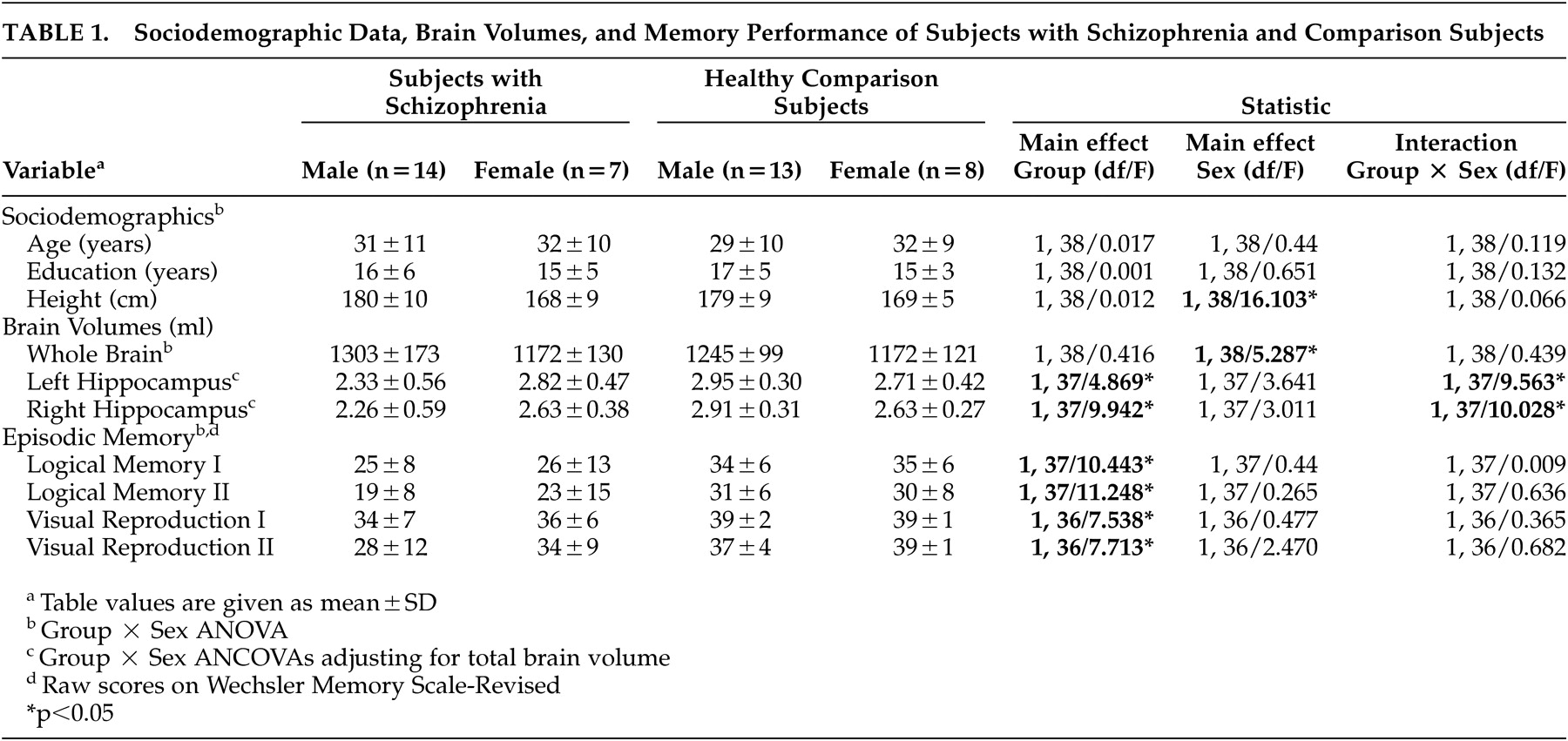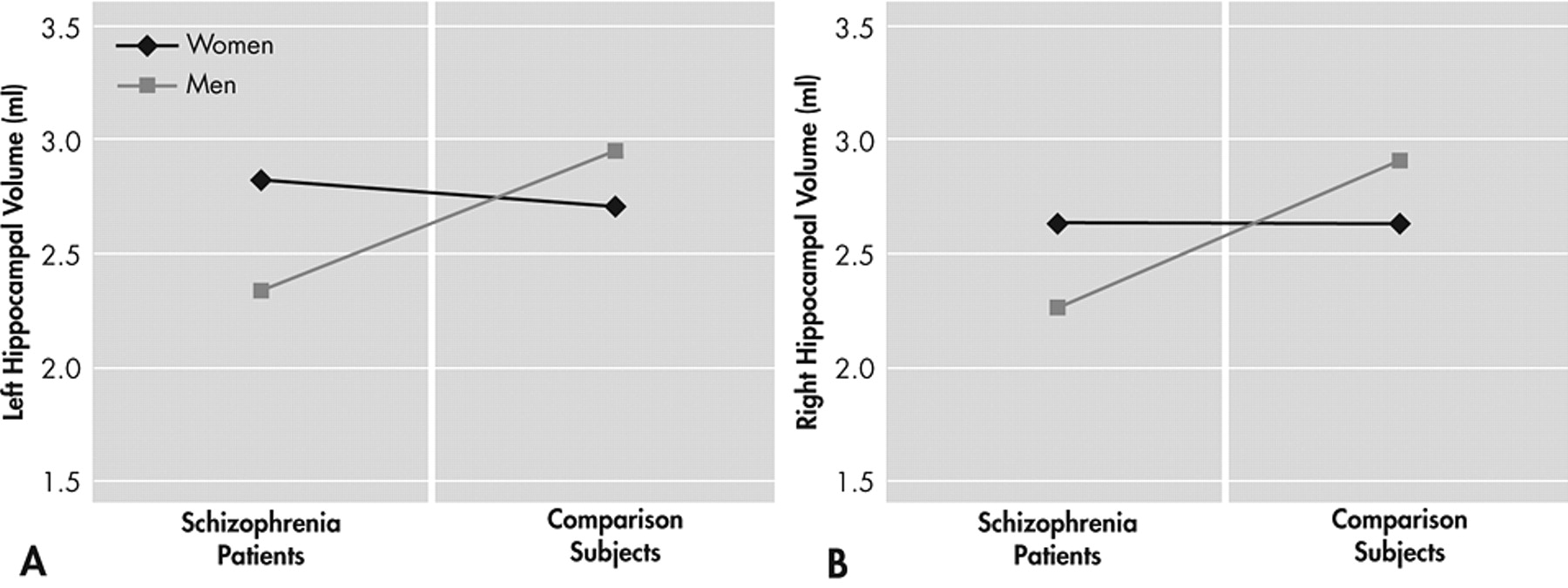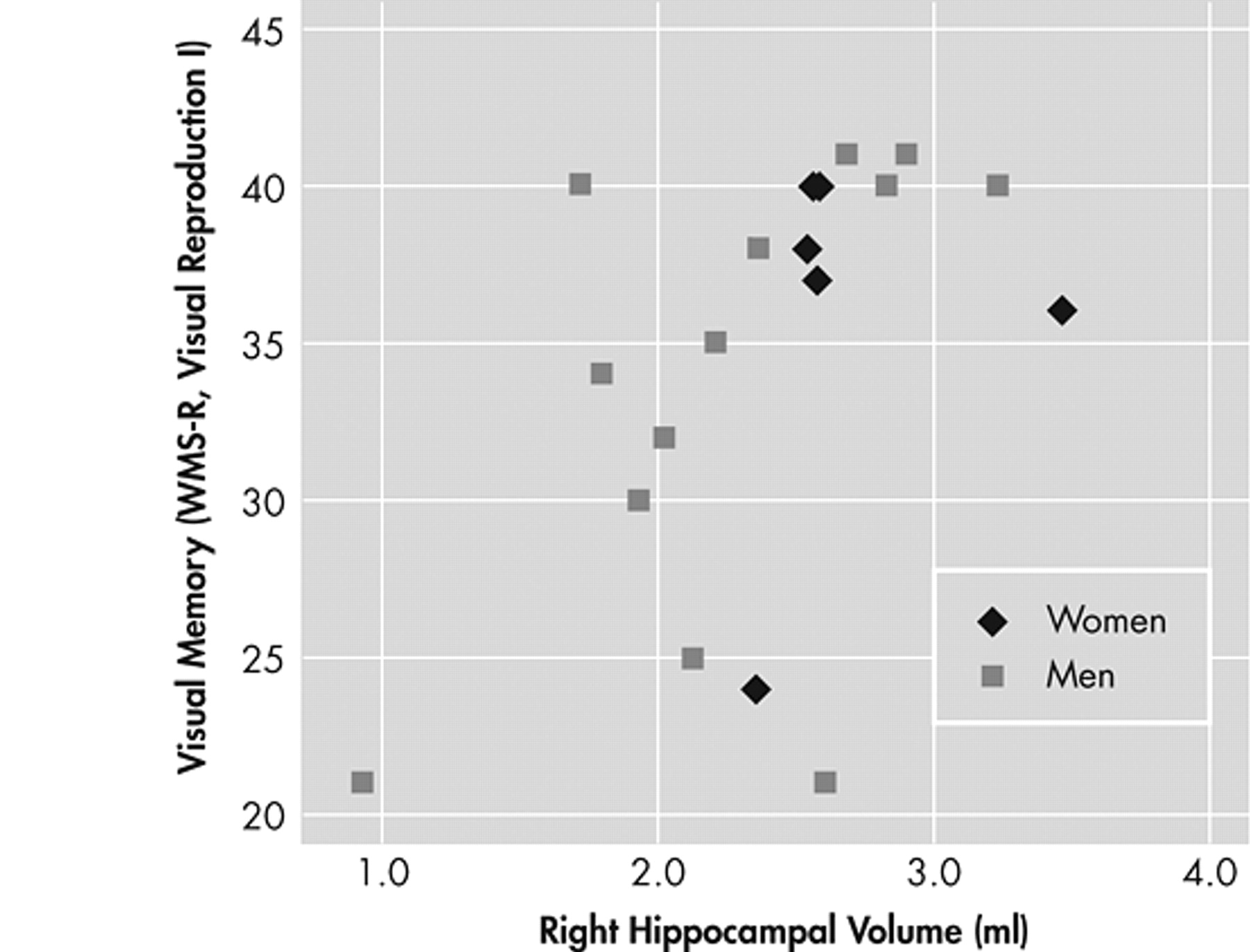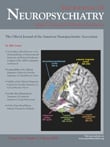A ccumulated evidence suggests that schizophrenia is associated with morphological and functional abnormalities of the hippocampus.
1 Hippocampal size and shape aberration in subjects with schizophrenia are assumed to represent the cerebral correlates of learning and memory deficits which are a key element of cognitive impairment in schizophrenia.
2,
3 The finding of reduced hippocampal volume in schizophrenia, however, is mainly based on evidence from male subjects (e.g., 80% males).
1 Studies that directly compared male and female hippocampal volumes have yielded inconsistent results.
4 –
6 Most studies have only assessed either brain morphology or cognitive performance. A direct relationship between hippocampal volume reductions in schizophrenia and memory impairment on the behavioral level has not consistently been shown.
7 The goals of our study were to investigate possible sex differences in hippocampal volume and episodic memory performance in schizophrenia and to analyze the relationship between memory performance in schizophrenia and hippocampal volumes.
METHOD
The sample comprised 21 inpatients (14 males, 7 females) who met DSM-IV criteria for a lifetime diagnosis of schizophrenia (SCID). Subjects with a history of head injury, neurological diseases, or substance dependence or abuse (SCID) were excluded. The mean duration of disorder was 8 (±9) years (females: 11±9; males: 7±9). Participants had experienced a mean of 3 (±2) previous hospitalizations (females: 3±2, males: 3±3). All subjects were on antipsychotic medication (mean chlorpromazine equivalent dose at testing was 501±416 mg/day; females: 419±356 mg/day, males: 542±450 mg/day). Male and female subjects with schizophrenia did not significantly differ on clinical variables (t tests, p>0.3 in all cases).
Subjects with schizophrenia were compared with 21 healthy comparison subjects without a history of neurological or psychiatric disorder who were closely matched for age, sex, years of education (full-time school and vocational/university education combined), height and handedness, and were paid for their participation. Sociodemographic data are separately given for group and gender in
Table 1 . Group by gender analysis of variance (ANOVA) revealed no differences between groups on these variables (p>0.5 in all cases). After complete description of the study informed written consent of all participants was obtained. The Ethical Committee of the Medical Faculty of the University of Marburg approved the study design.
All subjects received a magnetic resonance (MR) scan using a 1.5-Tesla clinical MRI scanner (Signa Horizon, General Electric Medical Systems) machine on the day of the assessment. Scanning parameters of the T 1 -weighted three-dimensional sequence (fast spoiled gradient recalled acquisition in the steady state; FSPGR) were as follows: TE=4.2 msec, TR=9 msec; flip angle=20 o ; number of excitations=3, FOV=25×19; slice plane=axial; matrix=256×256; slice thickness=1.4 mm (no gap); slice number=120.
Volumetric analysis was done on the basis of the individual 3D-MR images using the CURRY
® software (version 4.5; Neurosoft, Inc., El Paso, Tex.). Images were reformatted into continuous slices of 1 mm thickness. Total brain volume was calculated with automated multistep algorithms and 3D region growing methods that are limited by gray value thresholds. Simultaneous 3D visualization of brain structures and manual tracing allowed a precise identification and delineation of regions of interest. The hippocampus was disarticulated from surrounding tissue on coronal slices by means of manual tracing according to a standardized protocol
8 and the serial sections provided by Duvernoy.
9 The protocol had been developed to reduce discrepancies in hippocampal measurements between researchers. A single trained rater (BN), who was blind to the subjects’ test performance and clinical diagnoses, completed the analyses. The intrarater reliability based on 12 randomly chosen cases was r=0.91 (intraclass correlation coefficient).
Clinical and cognitive assessment and MR imaging of schizophrenia subjects were performed in a clinically stable phase within 3 weeks after admission. Symptom severity was assessed at the time of testing by using the Positive and Negative Syndrome Scale (PANSS) and resulted in a mean 80 (±26) total PANSS score. There was no significant difference between PANSS scores of female (87±34) and male (76±21) subjects (p>0.3). As episodic long-term memory is the cognitive function most severely disturbed in schizophrenia, and the one most closely related to hippocampal abnormalities,
2,
3 episodic verbal and visual memory was chosen as the main cognitive outcome variable. It was assessed with the subtests Logical Memory I and II and Visual Reproduction I and II, respectively, from the German version of the Wechsler Memory Scale—Revised (WMS-R).
Principal statistical methods used were analysis of covariance (ANCOVA) and Pearson’s correlations. Statistical comparisons were performed using the SPSS (SPSS for Windows, Version 12.0).
RESULTS
Two separate Group x Sex ANCOVAs comparing left and right hippocampal volume while adjusting for total brain volume revealed significant Group x Sex interactions for both hemispheres (
Table 1 ). Compared with male comparison subjects, male schizophrenia subjects had significantly smaller left (−21%) and right (−22%) hippocampal volumes. Hippocampal volume of female schizophrenia subjects did not differ from comparison subjects (
Figure 1 ).
Four separate 2 (Group) x 2 (Sex) ANOVAs comparing episodic memory performance revealed significant effects of Group (schizophrenia subjects showing lower performance on all four subtests) but no significant effect of Sex and no significant Group x Sex interaction (
Table 1 ).
Larger right hippocampal volume of subjects with schizophrenia was significantly related to visual memory performance (WMS-R, Visual Reproduction I, r=0.502, p=0.029). However, this significant positive relationship for the whole group could be attributed to the association between hippocampal volume and visual memory in male schizophrenia subjects (r=0.54, p=0.055) rather than female subjects (r=0.228, p=0.664) (
Figure 2 ).
No other significant relationship emerged between hippocampal volumes and memory performance (p>0.2 in all cases). In subjects with schizophrenia psychopathological measures (PANSS total score and subscores) were not related to hippocampal volume (p>0.2 in all cases) or cognitive measures (p>0.6 in all cases). Antipsychotic dosage was neither related to cognitive nor morphometric variables (p>0.2 in all cases). An additional anticholinergic medication in four schizophrenia subjects did not compromise memory performance (U tests, p>0.2 in all cases).
DISCUSSION
We found bilateral hippocampal volume reductions in male schizophrenia subjects while hippocampal volumes of female schizophrenia subjects did not differ from female comparison subjects. These sex differences were not due to insufficient statistical power for the female subgroup: means of female schizophrenia subjects and female comparison subjects were virtually identical (
Table 1 ) and sample size—though low—was sufficient to detect differences of the magnitude found for male subjects (effect size d=1.38). Sex differences on hippocampal volumes were also not attributable to differing sociodemographic or clinical sample characteristics of male and female schizophrenia subjects. Nevertheless, small samples always carry the risk of sampling biases.
Volume reductions of the hippocampal formation in first-episode and chronic schizophrenia are a consistent finding in MRI research
1,
10 but analyses have been mainly conducted with male subjects. Analyses of sexual dimorphism in schizophrenia hippocampal pathology have yielded inconsistent results with some studies reporting that male schizophrenia subjects are more affected,
4 and some finding no differences.
5,
6 More pronounced brain abnormalities in male schizophrenia subjects have, however, repeatedly been found for other brain structures, namely the lateral ventricles and the whole temporal lobe.
11 Sex differences in brain pathology of schizophrenia subjects have been attributed to an interaction between pathophysiological mechanisms and normal sexual dimorphism in brain development. Within the framework of neurodevelopmental hypotheses of schizophrenia it has been proposed that hippocampal volume reductions in schizophrenia reflect early impact on the developing brain rather than a genetic predisposition.
12 Male brains might be more vulnerable to brain insults because of delayed lateralization and lack of protection from estrogen.
13We could further show that reduced right hippocampal volumes in male schizophrenia subjects were specifically related to deficits of visual episodic memory. Reduced hippocampal volume might represent an anatomical substrate of deficient memory function in males with schizophrenia. A positive relationship between hippocampal volume and memory performance has been shown for other memory-impaired patient groups (e.g., premature born children)
14 but might be restricted to subjects with pathologically affected hippocampi. The fact that episodic memory deficits were also present in female schizophrenia subjects despite normal hippocampal volumes suggests that the pathophysiological mechanisms leading to memory deficits differ between the two sexes.
Small sample sizes in our study and acute illness state of schizophrenia subjects prevent firm conclusions from our results. However, our findings might stimulate further research relating to gender differences on morphometric and cognitive variables in schizophrenia. More research in larger and clinically stable outpatient populations is needed to confirm our findings.
Acknowledgments
The authors wish to thank Stephanie Mehl, Susanne Schwarz, Frieder Dressler, Kirsten Trapp, and Jessica Lehmann for their assistance in subjects’ assessments.




